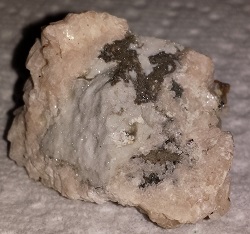A- |
B- |
C- |
D- |
E- |
F- |
G- |
H- |
I- |
J- |
K- |
L- |
M- |
N- |
O- |
P- |
Q- |
R- |
S- |
T- |
U- |
V- |
W- |
X- |
Y- |
Z |
CHALCOPYRITE:PHYSICAL CHARACTERISTICS:Color is brassy yellow, tarnishes to irredescent blues, greens, yellows and purples. Luster is metallic. Transparency: Crystals are opaque. Crystal System is tetragonal; bar 4 2m Crystal Habits are predominantly the disphenoid which is like two opposing wedges and resembles a tetrahedron. Crystals sometines twinned. Also commonly massive, and sometimes botryoidal. Cleavage is rather poor in one direction. Fracture is conchoidal and brittle. Hardness is 3.5-4 Specific Gravity is approximately 4.2 (average for metallic minerals) Streak is dark green. Other Characteristics: Some striations on most crystal faces. Associated Minerals are quartz, fluorite, barite, dolomite, calcite, pentlandite, pyrite and other sulfides. Notable Occurances include Chile, Peru, Mexico, Europe, South Africa, several USA sites and many others around the world. Best Field Indicators are crystal habit, tarnish, softness and brittleness. Chalcopyrite (or copper pyrite), looks like, and is easily confused with Pyrite, FeS2. Chalcopyrite is one of the minerals refered to as "Fool's Gold" because of its bright golden color. But real gold is a more buttery yellow and is ductile and malleable. As an ore od copper, the yield of chalcopyrite is rather low in terms of atoms per molecule. It is only 25%, compared to other copper minerals such as chalcocite, Cu2S - 67%; cuprite, Cu2O - 67%; covellite, CuS - 50% or bornite Cu5FeS4 - 50%. However the large quantities and widespread distribution of chalcopyrite make it the leading source of copper. Chalcopyrite is a common mineral and is found in almost all sulfide deposits. Fine crystals of chalcopyrite have a unique character and can add to anyone's collection. |

